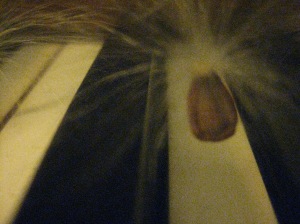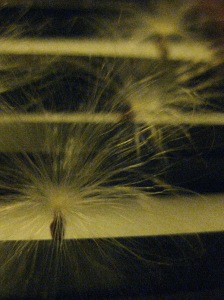And here we mark midwinter: the celebration of Candlemas, 40 days after Christmas, has become Groundhog’s Day, the morning when, it’s said, the groundhog emerges from his winter’s sleep to determine how long winter will continue. If he sees his shadow, we’re in for another six weeks of cold; but if February 2 is cloudy, that groundhog just may have courage enough to wake up, bringing spring along with him. Here in these mountains, most of us may feel as if we’ve barely been touched by winter. Grazed by cold, our dark days and long nights have been warm and wet for weeks now, as if we’re stuck in the endless bog of a northern tropic. Our orientation of time and place twists and turns; nothing is quite as we remembered it.
There’s a story “I am not a Jew”, by John Biguenet, that I heard a while back on the NPR radio show, Selected Shorts. In the story, a tourist wandering a German cemetery late at night finds himself suddenly surrounded by a gang of young men with shaved heads and hand-drawn tattooed swastikas. He realizes that he’s within the Jewish portion of the cemetery, surrounded by the etched names, the small faded photographs of men, women and children who’d died in the decades prior to the 1930s. As the men move closer, grabbing him by the collar and laughing at jokes that he, not fluent in German, doesn’t understand, he has a burst of clarity followed by relief as he realizes, they think I’m Jewish. I’m not. He falters in German to express the words that he senses will release him. I am not a Jew. I am not a Jew.
He repeats the words again and again, I am not a Jew, until finally, they release him, still laughing with contempt. He says, he is not a Jew, the leader announces in English. What are you?
Ich bien ein Americaner. I am not a Jew.
When he’s finally allowed to leave, there’s no indication that the situation would have gone otherwise had he not said what he did. They simply let him go, release him, without causing physical harm. He flees, lost in this strange city, but eventually makes his way back to his hotel where the elderly proprietor welcomes him in. Hearing the man’s story over a couple of late night drinks, the proprietor shakes his head sadly. “What else could you do?” he says, comfortingly. “Anyone would have done the same.”
The man repeats these words, incorporates them into his story. His wife was sleeping upstairs, and he doesn’t wake her as he comes to bed. And, although it burns within him, he doesn’t tell her the story of his adventure for several weeks. In fact, when he finally tells her, he does so in such a casual way that would admit to little ambiguity of emotion. What else could I do? Anyone would have done the same.
She shakes her head, as somehow, he must have known she would. No, she says. No.
“But I’m not a Jew,” he said, plaintively.
She looks sad, and explains, as if to a child: “That night, they divided the world into two kinds of people: Jews and Nazis. And you, you were not a Jew.”
This story has been haunting me ever since I first heard it. It has to do with identity, how we define ourselves internally and externally. It has to do with disclosure. It has to do with fear, how quickly we cast about for what identity will save us. We’re pack animals, we humans, and we’re safest when we’re surrounded by people who are like us. We’re forever seeking confirmation of who we are, as individuals, within a group. This feels particularly clear during political seasons, but that’s only one fairly coarse example. Most of us are mixed creatures, more “purple” than red or blue, marked more by bruises and blemishes and indifference than by genuine faith in particular codes or creeds. This isn’t a bad thing. Purity of heart is the gateway to barbarism, said someone once. Can we cling to uncertainty, to vulnerability, under pressure, rather than claim an identity through fear of being exposed? That’s the question.
I’m a musician, and I’ll turn for a moment to music for illustration. In the western musical tradition, we’ve created a language of harmonic dissonance and consonance. Consonance is harmonic stability; music often starts and finishes with consonance. Dissonance is considered unstable, often even abrasive or disruptive. It’s usually found in the middle; dissonance is the hero’s adventure, the thing that must be resolved. We feel unsatisfied unless a piece of music closes with a consonance. We’ve created that expectation for ourselves, and reinforced it in art, in narrative stories, in music, creating the traditions that would have us believe in stable conclusions. But life doesn’t always resolve in a tidy way.
In John Biguenet’s story, the story closes as the man lies in bed beside his now-sleeping wife. He asks himself, What else could I have done? And does not know.




